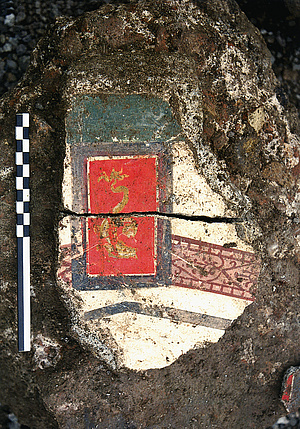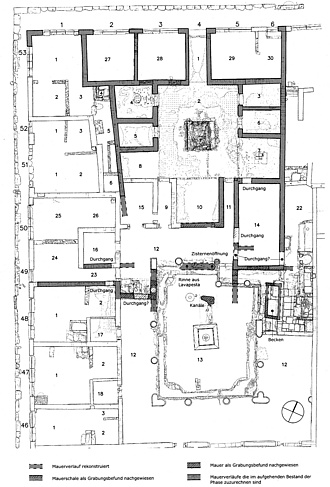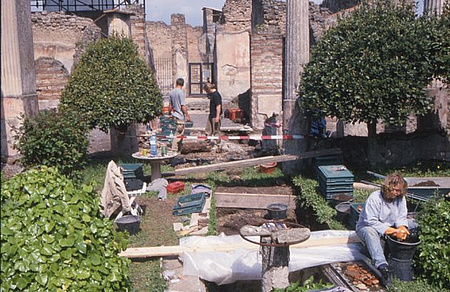Casa dei Postumii: Living and Working in one Building Complex
In the course of the past 250 years about two thirds of Pompeii were exposed, usually though only to the youngest level being used at the time of the eruption of the Vesuvius in 79 AD. On the older phases of the city’s history, the use of specific buildings and their alterations through the generations only little is known to this day.
Pompeii’s murals were able to attract most of the researchers’ attention. This resulted in only marginally addressing further-reaching questions regarding the living conditions in the ancient city.
It was only 30 years ago when research started to systematically ask for the social and economic forms of organisation, managing the coexistence of living and working, leisure and production.
Functions of a Building
For the exemplary investigation of a Pompeian house the Casa dei Postumii was chosen. The building complex combines a large residential building with a number of stores and workshops facing the street as well as several apartments on the upper floors, accessible from the outside. Results show, that in developing the lot proven and economically reasonable procedures were applied: While stores, workshops and apartments in the outer areas served the purpose of obtaining maximum profit from the lease, the owner used the vast inner area for building a residential building with a colonnaded courtyard (peristyle).

Investigation after 140 Years
The building had already been exposed in 1861. Although the architecture and furnishing comparably were well-preserved and the complex back then counted among the most impressive ruins, scientific research didn’t pay much attention to it.
Investigations performed between 1997 and 2002 addressed a complete documentation of the ruin’s current state, the implementation of archaeological excavation sections in order to clarify questions about previous users and about the conservation of the partially still well-preserved murals.
Literature
J.-A. Dickmann – F. Pirson, Repräsentatives Wohnen und kommerzielle Nutzung innerhalb eines Architekturkomplexes in Pompeji. Die Casa dei Postumii VIII 4, 4, 49 und ihre Insula. Bericht über die 1. Kampagne 1997, Römische Mitteilungen 105, 1998, 409-423.
J.-A. Dickmann – F. Pirson, Die Casa dei Postumii (VIII 4, 4, 49) in Pompeji und ihre Insula. Bericht über die 2. Kampagne 1998, Römische Mitteilungen 106, 1999, 383-394.
J.-A. Dickmann – F. Pirson, Die Casa dei Postumii (VII 4, 4.49) in Pompeji und ihre Insula. Bericht über die 3. Kampagne 1999, Römische Mitteilungen 107, 2000, 451-467.
J.-A. Dickmann – F. Pirson,Die Casa dei Postumii in Pompeji und ihre Insula. Bericht über die vierte Kampagne 2000, Römische Mitteilungen 108, 2001, 329-351.
J.-A. Dickmann – F. Pirson, Abitare e lavorare nell'antica Pompei. L'indagine nella Casa dei Postumii tra archeologia e tutela, in: F. Senatore (Hrsg.), Pompei tra Sorrento e Sarno (Roma 2001) 63-85.
J.-A. Dickmann u.a., Die Casa dei Postumii in Pompeji und ihre Insula. Fünfter Vorbericht, Römische Mitteilungen 109, 2002, 243-316.
J.-A. Dickmann – F. Pirson, Wohnen und Arbeiten im antiken Pompeji. Die Erforschung der Casa dei Postumii zwischen Archäologie und Denkmalpflege, Antike Welt 33, 2002, 81-94.
J.-A. Dickmann – F. Pirson, Il progetto Casa dei Postumii. Un complesso architettonico a Pompei come esemplificazione della storia dell'insediamento, del suo sviluppo e delle sue concezioni urbanistiche, in: P. G. Guzzo – M. P. Guidobaldi (Hrsg.), Nuove ricerche archeologiche a Pompei ed Ercolano (Napoli 2005) 156-169.
F. Pirson, Spuren antiker Lebenswirklichkeit. Fragestellung, Methodik und Ergebnisse der Untersuchung eines innerstädtischen Architekturkomplexes in Pompeji, in: R. Neudecker – P. Zanker (Hrsg.), Lebenswelten. Bilder und Räume in der römischen Kaiserzeit (Wiesbaden 2005) 129-145.
J.-A. Dickmann – F. Pirson, Pompei (Napoli). Casa dei Postumii, Bollettino di Archeologia, numero unico (2008) Bd. 2, 153-156.
J.-A. Dickmann, A "private" felter's workshop in the casa dei Postumii at Pompeii, in: Making textiles in pre-Roman and Roman times. People, places, identities (Oxford 2013) 208-227.
Further Information
Funding
This project is funded by the German Archaeological Institute in Rome, by the Bavarian Academy of Sciences and Humanities and STUDIOSUS Reisen, Munich.


